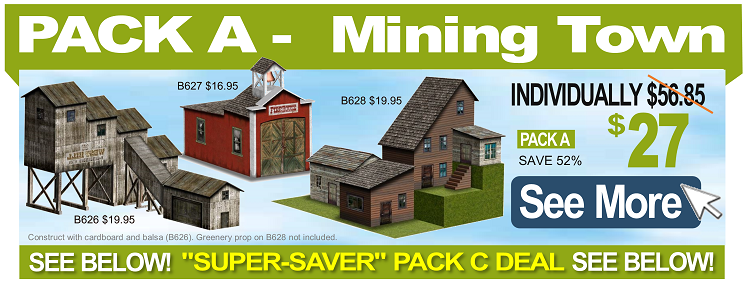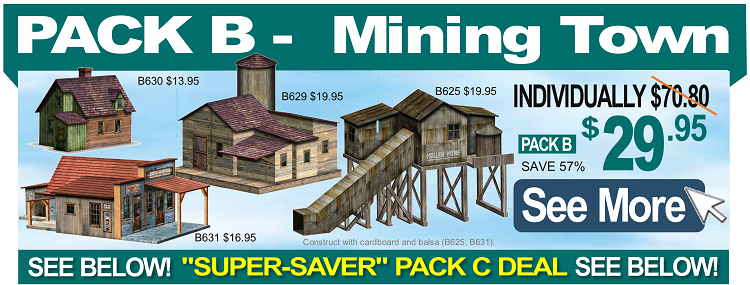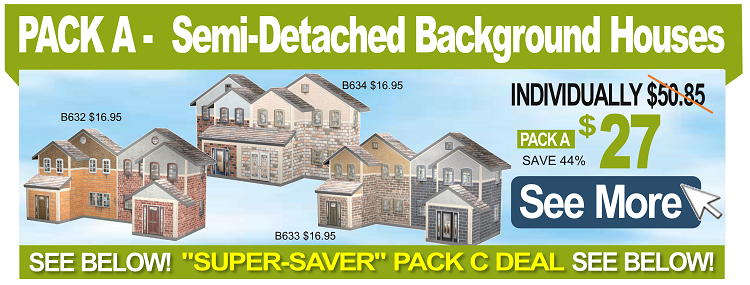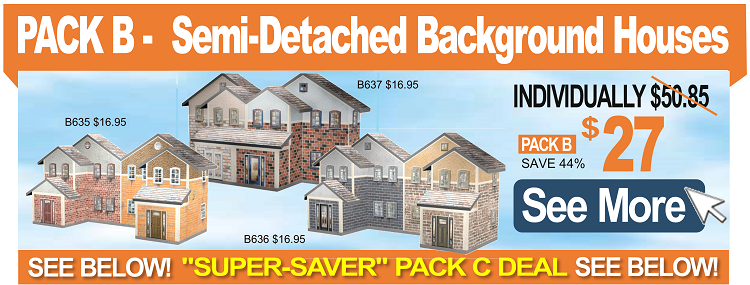Here are some short videos and helpful ideas to demonstrate construction methods for your railroad buildings, using both 3D and background plans.
If you model HO scale simply select the OO gauge option when purchasing any of the PDF plans from this website. HO is 87% of the size of the OO gauge plans so you can easily just adjust your printer settings accordingly. S scale is 119% of OO. If your require N scale choose N scale when purchasing. For Z scale change your printer settings to 73%.
This short videos explain how to make 3D model railroad buildings, in particular, the barn with grain silo structure featured on this website. Below this video is another video, and that one demonstrates how to make a backdrop structure using corflute.
This video demo shows how to construct a “low relief” backdrop structure for positioning against the background scenery and probably directly behind the railway track. The downloaded paper plans can be purchased here from our online model train store, printed out, and constructed using inexpensive (and very strong) corflute (available from DIY stores as well as many discount and art supply stores).
Sorry about the quality of these home-made videos, but they they will give you a good idea of possible construction techniques. Obviously you can use card, foam board or other materials and methods if you prefer. You can find the Goods Depot plan listed in the Railroad Structures category on the HOME PAGE.
Make your own realistically detailed wild west street scene with these 13 downloadable plans. Perfect for creating a small country and western town railroad scene. Scale plans also available for a constructing a mining town.
Download these “true-to-life” model railroad house designs… to make building scale model houses easier and more realistic than ever. Special pack deal available. See the full range of scale model house plans in the Residential category featured on the HOME PAGE.
4 “eye-catching” industrial buildings to add interest and realism to model railway backdrops and background scenery.
Download PDF paper plans for these 6 scaled shops that can be easily built using inexpensive corflute. The material is very strong and available in large sheets from DIY and discount stores.
Get plans for these “spectacularly photo-realistic” industrial silo facilities to Make for HO, N, S, Z, or N scale model railroads.
How to make remarkably realistic, low-cost OO gauge, N, and HO scale brick walls, arched walls, tunnel portals, arched bridges, a pedestrian overpass, and a concrete pylon road.
Many more designs available. Just click on the Home Page for more details,
where you can also download the FREE catalog
Making model railroad buildings from scratch is no longer difficult. These tutorial videos show step by step how to scratch build model railroad buildings. Just follow the methods explained and you’ll plenty of impressive looking architecture to place around your train layout. These cardstock railroad model buildings look prototypical and are extremely strong when constructed using the methods described. The downloadable plans take only a few moments to download and print out ready-for-assembly.
The History of Model Trains and Buildings
Contributor: Dave Walker
The history of the model trains began in the mid 1800’s and continues to this day. Electric trains appeared in the early 1900’s and participants immediately began to build scenes with tracks, buildings, lights, tunnels, mountains, bridges, streams, vehicles, roads and signals.
As the hobby of railway modeling grew, manufacturers began to produce the trains in different sizes known as scales. The best of these hobbyists then created their structures, buildings and scenery to the same scale as their trains. In this manner they create very realistic worlds in which the trains become the centerpiece. The scale of the trains runs from life size and even drivable trains down to tiny T scale (T Gauge) at just 1:450 real size.
Model Train Scales
There are some standard model trains and buildings including HO, OO, S, O, G, N, and TT. The best known of these to the model train builder are the HO (OO in UK) and N scales. In more recent years the industry has introduced two new scales those being the Z-scale and the already mentioned T Gauge.
The process of building up your landscape and your scenery can be as easy as buying off the shelf kits (they can be expensive) and putting them together, to creating them from scratch. In the early days of railroad modeling the buildings might be just drawings attached to sticks and placed near the tracks. This has evolved to the full room landscapes and layouts we see today with intricate structures and towns full of detailed buildings. The buildings continue to evolve from perfect replicas of early 19th century towns to gleaming towers of modern glass and steel cities. For the railroad modeler the buildings can be just as important if not more important than the train itself.
Many of the same manufacturers who were responsible for the history and growth of the model train, were also responsible for the history and growth of the buildings as well. These included Bachmann, American Flyer and Lionel. Others were Hornby, Marklin, and Arnolds. These companies made building kits and stand-alone buildings. In the United States in the 1950’s and 60’s Lionel was the king of the trains, tracks and building kits. Bachmann is now the popular choice for many.
How Lionel Trains Began
Joshua Lionel Cowen made his first train car in 1901 and sold over 50 million sets and produced over 300 miles of track every year. Along with this Lionel Trains sold millions of building kits. In 1953 Lionel was the world’s largest toy company. In 1999 Lionel trains were named as a top ten toy for the 20th century with the quality of their trains and building kits leading the way.
The first Lionel trains were life size window displays for toy companies. In 1902 the Lionel Manufacturing Company created the “City Hall Trolley” and their first building structure – a suspension bridge that stood almost two feet tall. Throughout the early 1900’s, Lionel trains became toy size and the track was innovated to have three rails. More and more cars and buildings and structures were introduced every year. By 1909 Lionel proclaimed themselves to be the train ‘standard of the world’. With the advent of electricity in every home electric model trains were a boon business. It was 1915 when the O gauge was first offered and soon it was the standard bearer and the most popular gauge scale of all trains and buildings.
Many railroad modelers today think that the Lionel trains, structures and buildings that were manufactured after World War II were the best ever made. Lionel trains, buildings and structures declined in popularity by the beginning of the 1960’s but with the advent of the Baby Boomers entrance into middle age, they began collecting their childhood toys with a vengeance. Lionel trains and model train buildings kits were at the top of many Baby Boomers lists. The buildings, structures and trains are still sold new today.
American Flyer was another American company that made trains, tracks and buildings in the early 1900’s before the trains were sold to the A.C. Gilbert Company. In the 1950’s this company produced the best know AF trains, buildings and accessories. The Flyer originally made in S gauge was also made in O gauge as early as 1905.
Most of the plastic building kits you can buy today are made by several different model railroad companies, many with a long history in the model train game. The list includes Life-Like, Atlas, Model Power, and Bachmann. So as you can see train models have been around a long time.










